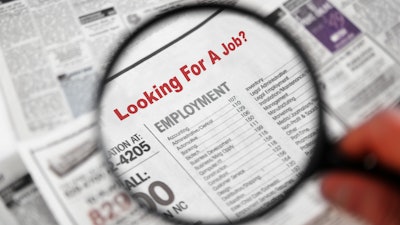
Though “Help Wanted” signs likely aren’t going away any time soon, there’s a chance America’s prolonged employment shortage could lessen a bit in the weeks and months ahead.
In a little more than a week, on Monday, Sept. 6, unemployed Americans in 24 states will no longer be eligible to receive an extra $300 per week on top of their existing unemployment benefits provided by the $1.9 trillion American Rescue Plan passed in March.
Unemployed Americans were first provided additional unemployment benefits in 2020 through the CARES Act. The American Rescue Plan extended the program, and President Biden remarked at the time the additional payments were necessary to give “the backbone of this nation — the essential workers, the working people who built this country, the people who keep this country going — a fighting chance.”
Yet in the months since the benefits were extended, America’s economy has boomed but its workforce has not.
America had its best month of job growth in nearly a year in July but remains nearly 6 million workers below where it stood in February 2020. Nearly 9 million people remain unemployed, according to the Bureau of Labor Statistics (BLS), while 6.5 million more claim to want a job but are not looking for one. Those latter totals are on a downward swing but have not fallen at a rate that would be expected considering America’s Gross Domestic Product (GDP) rose by 6.5 percent in Q2.
More than two dozen states cited that data and other sources in announcing they would prematurely end the additional $300 weekly benefit payments in recent months. The rest of the nation will follow suit in ten days.
It will be interesting to see what happens next month once those additional benefit payments expire. There is sentiment in America’s business community (not just trucking but all sectors) that a small but consequential segment of the American workforce has chosen to “sit out” the pandemic for safety and financial reasons.
[RELATED: Understanding young techs is vital to keeping them]
This theory posits that workers across the nation who lost their jobs in the early days of the pandemic have consciously avoided returning to the workforce in the months since, choosing instead to accept additional unemployment funding and the security of staying home and away from the front lines of the virus.
Now, is that theory true? Maybe? Probably in some isolated cases? I can’t disprove it, but I also doubt it’s the reason 6 million Americans haven’t returned to work, especially considering the sheer number of open positions across the country.
I’m sure in the early months of the pandemic, after the first COVID relief packages were announced, there were workers who decided they would be more secure (financially and from a health perspective) if they took the additional benefits and avoided returning to roles where they felt their risk of contracting COVID-19 was high.
I don’t think that’s the case today. Here’s why.
First, applying for and receiving unemployment benefits is not a swift process. Some states are easier than others but applying for unemployment isn’t like ordering a pizza on your phone. You might be able to fill out an application in short order, but your money doesn’t arrive in 30 minutes. It can take months — and that’s assuming you’re approved to get anything at all. Some people might have been willing to put up with that process last spring, but I’d think by now they’d be tired of the bureaucracy and uncertainty when steady, stable work is so freely available.
[RELATED: DEI and the long-term benefits of workforce diversity]
There’s also the matter of the extra $300. When the Federal government first introduced the additional unemployment assistance last year it was $600 a week and every state participated. Now its half that, and fewer than half the states are still offering it, which means for a lot of Americans there’s no additional financial benefit to being unemployed now than there was pre-pandemic.
And we have COVID-19 vaccines now. Unemployed workers who feared for their safety last summer can now walk into any corner drugstore and get one of three vaccines that reduce their likelihood of a COVID infection and hospitalization. (The Pfizer vaccine earned full FDA approval on Monday.)
I think ending the additional unemployment benefits program on Sept. 6 is going to help employment a little. The aforementioned July jobs report wasn’t fantastic but it was a step in the right direction. I think August will be the same and September will be better. I think people who chose to stay home for their safety — however many there were — aren’t going to be able to do that anymore.
But I also think if we’re going to make any serious dent in our national worker shortage, the solution isn’t altering unemployment benefits. It’s childcare.
Millions of parents learned first-hand how exhausting juggling a career, childcare and a virtual education was last year and for a lot of them, the task was overwhelming. Many exited the workforce voluntarily to be home with their kids and a year later, they’re still there. If we want to end the employment shortage, those are the workers we need to bring back.
I’m optimistic this school year will allow more in-person learning than the last two. Maybe as the year progresses parents will slowly begin to trickle back into the workforce, assuming their kids can stay in class. In my house we’re on Day 8 of a 14-day quarantine due to a COVID exposure at daycare and even with both of us working remotely (me full-time and she due to an ongoing office closure), it’s hard. I don’t know how we’d manage it if we had to be AT the office. Probably leverage the grandparents even more than we do now.
Not every family has our remote work and extended family advantages. Which means until the country can beat this thing back enough to keep schools running smoothly, hiring is going to be a challenge.
So, if you do need people (and I assume everyone does) try to make the best of next month’s change. It might not lead to as many new applicants as you’d hope but it’s a step in a positive direction. And I don’t think any of us know when we’ll see a better opportunity.










